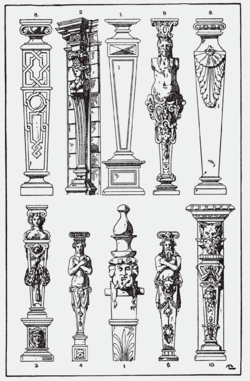Term (architecture)
In Classical architecture a term or terminal figure (plural: terms or termini) is a human head and bust that continues as a square tapering pillar-like form.

The name derives from Terminus, the Roman god of boundaries and boundary markers. If the bust is of Hermes as protector of boundaries in ancient Greek culture, with male genitals interrupting the plain base at the appropriate height, it may be called a herma or herm. The crime of Alcibiades and his drinking-mates, for which Socrates eventually indirectly paid with his life, was the desecration of herm figures through Athens in the dead of night.
At the Temple of Artemis at Ephesus, the Lady of Ephesus, whom the Greeks identified with Artemis, was a many-breasted goddess encased in a tapering term, from which her feet protruded. (See illustration at Temple of Artemis).
In the architecture and the painted architectural decoration of the European Renaissance and the succeeding Classical styles, term figures are quite common. Often they represent minor deities associated with fields and vineyards and the edges of woodland, Pan and fauns and Bacchantes especially, and they may be draped with garlands of fruit and flowers.
Term figures were a particularly characteristic feature of the 16th-century style in furniture and carved interior decoration that is called Antwerp Mannerism. Engravings disseminated the style through Germany and England.
Term figures as table supports or employed as candlestands (French guéridon) were characteristic of the Late Baroque Louis XIV style in France, the Low Countries and England, revived in the neo-Palladian furniture designed by William Kent and employed again in the French Empire style of the early 19th century.[1]
Notes
- "Gueridon – definition". Internet Antique Gazette. Retrieved 21 February 2013.
References
- Cyril M. Harris (1977). Illustrated Dictionary of Historic Architecture. Courier Dover Publications, ISBN 0486132110; p. 528
- George L. Hersey (1988). The Lost Meaning of Classical Architecture. MIT, ISBN 0262580896; p. 129
External links
| Wikimedia Commons has media related to Terms. |
- . Encyclopædia Britannica. 26 (11th ed.). 1911. p. 642.
- Pair of terminal statuettes (The Metropolitan Museum)
- Terminus / Term / Terminal figure (Buffalo Architecture Index)